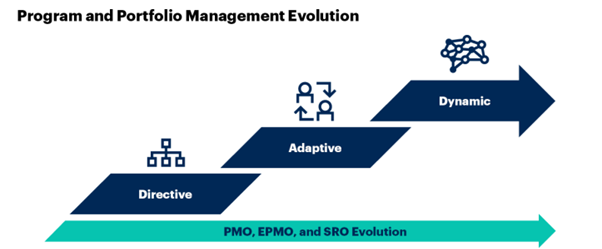Our recent blog post, Avoiding PMO Failure, outlined the top reasons why a PMO might fail and how a PMO can be structured to guarantee its longevity. But it doesn’t end there. It is not only about your PMO surviving, but continuously evolving to provide ongoing value to your organisation as your business needs and goals change.
According to Gartner, “PMO leaders are challenged with stagnating PMOs that rely too heavily on their original premise and purpose. PMO leaders must evolve the PMO to be a proactive, strategic organisation that enables value contributions through aligned investments and adaptive, continuous delivery.”
In this blog post, we summarise Gartner’s strategic evolution of the PMO which we showcased in our recent webinar, 2022 Strategic Roadmap for the PMO, and we outline how you can best plan for migration to achieve a valuable, dynamic PMO.

Directive PMO
The strategic evolution of a PMO typically begins with an acknowledgement that the PMO relies too heavily on an established command-and-control approach.
The directive approach creates an overly bureaucratic model for managing programs and projects and typically does not match the time-to-value expectations of a modern business.
Adaptive PMO
When business leaders need continuous delivery and faster responses from the PMO, their view of the directive approach becomes less favourable.
To evolve to a more adaptive strategy, PMOs adopt agile-like principles and approaches to work execution. The PMO also encourages higher levels of engagement and collaboration to support continuous delivery and more readily meets the changing needs and requirements of the organisation.
Dynamic PMO
A dynamic PMO supports the definition, tracking and realisation of organisational value in measurable terms. The PMO achieves recognition as a dynamic, value driven function only when the business views it as a trusted partner that creates value directly tied to key business objectives and outcomes.
PMO leaders must guide their current PMO toward a widespread domain-to-business partnership by evolving from directive and adaptive states to an effective, dynamic state. This can be achieved by using the PMO strategic roadmap and timeline guide outlined below.
PMO Strategic Roadmap & Timeline Guide
| Future State (Dynamic PMO) | Current State (Directive PMO) |
|---|---|
| > A recognised value organisation > Has a strategic partnership with business leaders > Collaborates with business leaders for strategic portfolio management > Utilises adaptive and efficient planning and execution > Extends its sphere of influence beyond the domain in which it resides > Adopts and uses a repeatable and scalable organisational change methodology > Uses modern technologies required to support effective planning and multiple methods of delivery | > Lacks clear identity, value proposition and purpose > Has no partnership with key business leaders > Is in a reactive state and overwhelmed with demand and severely constrained supply > Is constrained by the enterprise’s organisational style > Cannot adapt easily to changing priorities > Cannot change its sphere of influence, which remains in the domain > Is missing a repeatable and scalable organisational change methodology > Uses stagnating portfolio and work management technologies |
Differences between a Directive and a Dynamic PMO
In order to position the PMO as a strategic contributor of business value, leaders must learn to close the gaps between a current-state, outdated directive PMO and the dynamic PMO.
The gaps between a directive PMO and a dynamic PMO are:
- An incomplete or missing strategic partnership with business leaders
- A lack of understanding of key business strategies and desired business outcomes
- No collaborative portfolio prioritisation process between business leaders and the PMO
- Inconsistent or missing communication between business leaders and the PMO
- Missing PMO competencies supporting strategic portfolio alignment and continuous delivery
- No strategy and tactics for communication and organisational change
- An inability of business leaders to affirm business value creation from PMO contributions
- A lack of modern technologies supporting strategic portfolio management and adaptive, continuous execution
How to plan for Migration between Directive and Dynamic PMO
To evolve the PMO from directive to dynamic, PMO leaders must first acknowledge that the PMO needs to evolve and that failure to evolve may cause the PMO function to stagnate and become irrelevant.
PMO leaders must dramatically change the identity and purpose of the PMO, and they must do so in conjunction with the business.
Steps in the PMO migration plan are:
- Form and use key strategic partnerships: A strong partnership between PMO and business leaders can produce solid strategy to execution connection. The PMO leader must work towards:
- Identifying strategic partnerships with key business leaders
- Redefining the PMO with business leaders
- Establishing continuous communication with business leaders
- Enable strategic portfolio management and execution: Once PMO leaders and key business leaders have jointly created the blueprint for a redesigned PMO, both parties must continue to work together and:
- Create a collaborative portfolio prioritisation process
- Enhance competencies based on the PMO’s new role and purpose
- Define all business-value based metrics
- Affirm business value and extend the PMO’s sphere of influence: In this stage of PMO evolution, PMO leaders must:
- Measure value creation with business leaders
- Adopt technologies that support adaptive portfolio management and continuous delivery
- Accelerate cross-functional contributions
To learn more about how you can best plan and prepare to transform your PMO into a valuable dynamic PMO, get in touch with the Sensei PPM experts today.
Download Gartner Research
Fill out your details below to access Gartner’s 2021 Strategic Roadmap for the PMO Report.
By Marc Soester
Marc Soester is an Executive Director at Sensei and has over 18 + Years experience in being a PPM and Work Management Subject Matter Expert, he has been part of over 250 PPM implementations and is an Industry Standard Expert on PMI, P3O, Scaled Agile. Marc was also the first Microsoft Project MVP and is an active member of the Microsoft Product Advisory Council.



